An article on page 6 of last week’s paper (7 January) highlighted the work being done to accurately map peatland across NI, with an estimated 12% of land area in a combination of lowland raised bogs, blanket bog and fens. In total, up to 18% of NI is underlain with peat soil.
Our peatland stores millions of tonnes of carbon built up over thousands of years, however a range of factors can affect its condition, with local estimates suggesting around 80% is in a degraded state and adding to NI greenhouse gas emissions. However, when restored, not only do the emissions cease, once sphagnum moss re-establishes it will start to lock up carbon again and help lower overall NI emissions.
Peatlands are also important for biodiversity as they are home to a unique range of wildlife. In addition, they have a role to play in flood regulation, slowing the flow of water downhill and reducing the frequency of flash flooding, which will be an increasing issue with climate change. Finally, these areas are also important for drinking water quality – bare and eroding peatland causes brown discolouration in drinking water that is expensive to remove.
Our peatland stores millions of tonnes of carbon built up over thousands of years, however a range of factors can affect its condition
“With the right policies in place, we can turn this around. But we need to act now,” suggests Jennifer Fulton, the chief executive of Ulster Wildlife.
Ulster Wildlife has been involved in a number of initiatives to restore peatland and along with the James Hutton Institute, is leading the mapping project in NI.
Jennifer is keen to dispel some of the myths around the issue, and points out that while most peatland might benefit from restoration, it does not imply this land is being badly managed by farmers. Instead, peatland may have had drains installed by a previous generation to facilitate turf cutting, or to allow it to be planted out in trees. “The site might have been virtually untouched for over 50 years, but those drains are still having an impact in drying out the bog,” she said.
To get this land back into a healthy state, whereby bog plants (especially sphagnum) are thriving, it is necessary to raise the water table close to the surface by blocking drains and ditches. The commonly used term is re-wetting, but it is not terminology Jennifer likes to use, as it suggests the area will be turned into some sort of swamp.
“The aim is to get the water table to within about 10 to 15cm of the surface for 90% of the year. If we achieve that, it will be actively forming peat,” she said.
Costs
The cost of doing that work will vary depending on the site, but in Scotland, where significant restoration work is now underway, the average is around £1,000 per hectare.
In NI, it is hoped that these costs will be covered by the Stormont Executive’s Green Growth strategy in future, but beyond that, there is then the necessary annual maintenance of a site, whether it is checking dams, upkeep of fences or stopping scrub encroachment.
“That is where future agri-environment schemes must come in and provide an annual payment to reward farmers for protecting and managing this natural asset, which is important to wider society,” suggests Jennifer.
As well as a financial incentive, restored peatland can help offset emissions from other farming activities when calculating the overall carbon footprint of the farm.
Lowland raised bogs are typically found in the west of NI, forming where there is a depression in the landscape.
Unlike blanket bogs in the uplands, these lowland bogs are not usually grazed by livestock, mainly for fear of animals being lost in hollows and drains, and also because there isn’t an economic benefit, given the lack of vegetative growth.
However, a typical bog can have multiple landowners, often related to historic agreements to cut turf, and if an area of bog is to be restored, all these landowners will need to be onside.
Getting that permission was among the challenges encountered in the five-year EU-funded CANN (Collaborative Action for the Natura Network) project, which sought to restore peatland at various cross-border designated sites (all were Special Areas of Conservation – SAC).
“When we approached landowners, some didn’t care and were happy for us to work away, while others were very interested. There was a range of responses, but generally it was positive,” said Simon Gray, a technical officer with Ulster Wildlife, one of the partners in the CANN project.

Cranny bogs is a site covering 78ha outside Fintona in Co Tyrone.
The project is now complete, and one of the peatlands restored was at Cranny bogs, which is a site covering 78ha on three bogs; Killymoonan, Fallaghearn and Cavan, located just outside Fintona in Co Tyrone.
The bogs, which have peat down to 8m in places, had historically been earmarked for tree planting, with a large drain dug down one side.
Track digger
The restoration work involved installing hundreds of dams at 10m spacing across the site in the early part of 2020 using a track digger.
“It all has to be winter work – we are prohibited during the bird nesting season. We also need consent from the NI Environment Agency to work on a SAC, as well as the landowners,”
“Digging on these sites is a skilled operation, and from our experience, those best placed to do the work are local contractors or landowners with knowledge and experience of working on bogs,” explained Simon.
The machine operator digs a barrow pit of peat and uses this to create the dam, placing a layer of vegetation on top.

Digger work to block drains on Cranny bogs was done in early 2020.
Given the weight of the machine and the soft ground, wide tracks and bog mats are often used. Where a digger can’t get in, plastic dams are an alternative.
In Scotland, an industry has emerged around this type of restoration work, and Simon believes something similar can happen in NI.
Control
Once the bog is restored, it is important to keep scrub under control.
Any trees or large woody plants need to be removed, as they tend to shade out bog plants and dry out the site. Rhododendron has been a big problem on many sites, including Peatlands Park outside Dungannon.
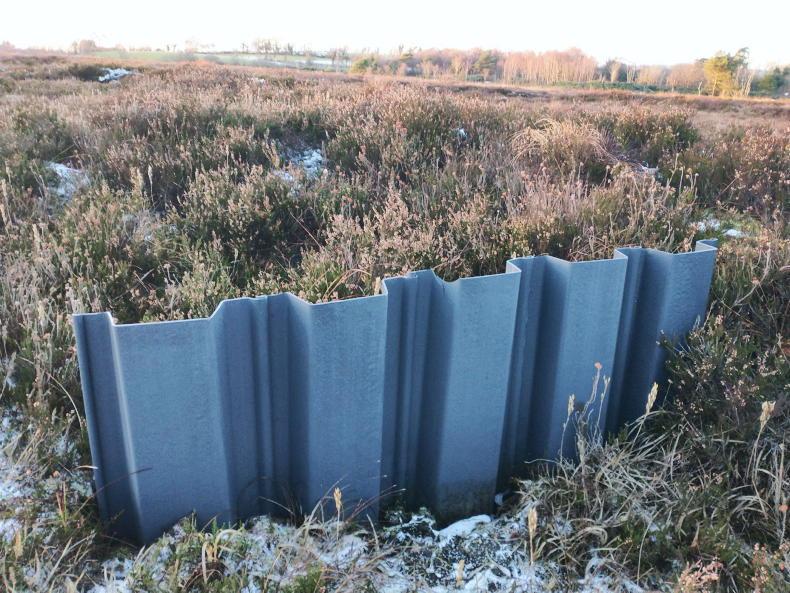
Where a digger can't access parts of a site, plastic dams are an alternative.
“But if we get the hydrology right, the bog can generally take care of itself. It is pretty straightforward,” said Simon.
A restored lowland bog will provide a suitable habitat for the likes of breeding waders and should also be more resilient to ammonia deposition, as the plants that would normally respond to the nitrogen from ammonia will not do well in prevailing wet conditions.
Blanket bogs tend to be found in our uplands and restoring peatland in these areas can be more complex than in a lowland raised bog. The main issues encountered tend to be damage caused by drainage, over-grazing by livestock (usually historic) or tree planting, all of which lead to peatland drying out, surface vegetation being lost and bare peat being exposed. As part of the CANN project, funding was provided for restoration work at Cuilcagh Mountain in Co Fermanagh, where two main problems were addressed. The first is where surface vegetation is lost and this leads to erosion gullies forming, which ultimately results in steep-sided gully channels and isolated peat islands. In a number of areas across the mountain, a digger was used to grade these steep edges down to 30 to 35° slopes.
The second issue is at the base of the gully channels, where work was undertaken to stop erosion caused by weathering and the flow of water, mainly by using coir rolls (made from the outer husk of coconuts) to trap sediment.
“We tried using rolls made out of sheep fleece – they largely have worked. It is probably not as 100% effective as the coconut, but it is definitely an alternative that needs more investigation,” said Simon.
Vegetation
Slowing the flow of water off upland areas has numerous benefits, whether it is reduced flood risk downstream, improved drinking water quality or lower fire risk.
However, while over-grazing can be an issue in some situations, there is also the problem of under-grazing, leading to heather becoming too strong or other parts of the land being dominated by a dense carpet of rushes, neither of which will benefit the wildlife.
“Where upland bog is eroded, there may need to be some change to the grazing regime, but longer-term, we need grazing to continue in these areas,” said Simon.
Read more
Peatland map to identify key areas for action
Billions of tonnes of carbon stored on NI farms
An article on page 6 of last week’s paper (7 January) highlighted the work being done to accurately map peatland across NI, with an estimated 12% of land area in a combination of lowland raised bogs, blanket bog and fens. In total, up to 18% of NI is underlain with peat soil.
Our peatland stores millions of tonnes of carbon built up over thousands of years, however a range of factors can affect its condition, with local estimates suggesting around 80% is in a degraded state and adding to NI greenhouse gas emissions. However, when restored, not only do the emissions cease, once sphagnum moss re-establishes it will start to lock up carbon again and help lower overall NI emissions.
Peatlands are also important for biodiversity as they are home to a unique range of wildlife. In addition, they have a role to play in flood regulation, slowing the flow of water downhill and reducing the frequency of flash flooding, which will be an increasing issue with climate change. Finally, these areas are also important for drinking water quality – bare and eroding peatland causes brown discolouration in drinking water that is expensive to remove.
Our peatland stores millions of tonnes of carbon built up over thousands of years, however a range of factors can affect its condition
“With the right policies in place, we can turn this around. But we need to act now,” suggests Jennifer Fulton, the chief executive of Ulster Wildlife.
Ulster Wildlife has been involved in a number of initiatives to restore peatland and along with the James Hutton Institute, is leading the mapping project in NI.
Jennifer is keen to dispel some of the myths around the issue, and points out that while most peatland might benefit from restoration, it does not imply this land is being badly managed by farmers. Instead, peatland may have had drains installed by a previous generation to facilitate turf cutting, or to allow it to be planted out in trees. “The site might have been virtually untouched for over 50 years, but those drains are still having an impact in drying out the bog,” she said.
To get this land back into a healthy state, whereby bog plants (especially sphagnum) are thriving, it is necessary to raise the water table close to the surface by blocking drains and ditches. The commonly used term is re-wetting, but it is not terminology Jennifer likes to use, as it suggests the area will be turned into some sort of swamp.
“The aim is to get the water table to within about 10 to 15cm of the surface for 90% of the year. If we achieve that, it will be actively forming peat,” she said.
Costs
The cost of doing that work will vary depending on the site, but in Scotland, where significant restoration work is now underway, the average is around £1,000 per hectare.
In NI, it is hoped that these costs will be covered by the Stormont Executive’s Green Growth strategy in future, but beyond that, there is then the necessary annual maintenance of a site, whether it is checking dams, upkeep of fences or stopping scrub encroachment.
“That is where future agri-environment schemes must come in and provide an annual payment to reward farmers for protecting and managing this natural asset, which is important to wider society,” suggests Jennifer.
As well as a financial incentive, restored peatland can help offset emissions from other farming activities when calculating the overall carbon footprint of the farm.
Lowland raised bogs are typically found in the west of NI, forming where there is a depression in the landscape.
Unlike blanket bogs in the uplands, these lowland bogs are not usually grazed by livestock, mainly for fear of animals being lost in hollows and drains, and also because there isn’t an economic benefit, given the lack of vegetative growth.
However, a typical bog can have multiple landowners, often related to historic agreements to cut turf, and if an area of bog is to be restored, all these landowners will need to be onside.
Getting that permission was among the challenges encountered in the five-year EU-funded CANN (Collaborative Action for the Natura Network) project, which sought to restore peatland at various cross-border designated sites (all were Special Areas of Conservation – SAC).
“When we approached landowners, some didn’t care and were happy for us to work away, while others were very interested. There was a range of responses, but generally it was positive,” said Simon Gray, a technical officer with Ulster Wildlife, one of the partners in the CANN project.

Cranny bogs is a site covering 78ha outside Fintona in Co Tyrone.
The project is now complete, and one of the peatlands restored was at Cranny bogs, which is a site covering 78ha on three bogs; Killymoonan, Fallaghearn and Cavan, located just outside Fintona in Co Tyrone.
The bogs, which have peat down to 8m in places, had historically been earmarked for tree planting, with a large drain dug down one side.
Track digger
The restoration work involved installing hundreds of dams at 10m spacing across the site in the early part of 2020 using a track digger.
“It all has to be winter work – we are prohibited during the bird nesting season. We also need consent from the NI Environment Agency to work on a SAC, as well as the landowners,”
“Digging on these sites is a skilled operation, and from our experience, those best placed to do the work are local contractors or landowners with knowledge and experience of working on bogs,” explained Simon.
The machine operator digs a barrow pit of peat and uses this to create the dam, placing a layer of vegetation on top.

Digger work to block drains on Cranny bogs was done in early 2020.
Given the weight of the machine and the soft ground, wide tracks and bog mats are often used. Where a digger can’t get in, plastic dams are an alternative.
In Scotland, an industry has emerged around this type of restoration work, and Simon believes something similar can happen in NI.
Control
Once the bog is restored, it is important to keep scrub under control.
Any trees or large woody plants need to be removed, as they tend to shade out bog plants and dry out the site. Rhododendron has been a big problem on many sites, including Peatlands Park outside Dungannon.

Where a digger can't access parts of a site, plastic dams are an alternative.
“But if we get the hydrology right, the bog can generally take care of itself. It is pretty straightforward,” said Simon.
A restored lowland bog will provide a suitable habitat for the likes of breeding waders and should also be more resilient to ammonia deposition, as the plants that would normally respond to the nitrogen from ammonia will not do well in prevailing wet conditions.
Blanket bogs tend to be found in our uplands and restoring peatland in these areas can be more complex than in a lowland raised bog. The main issues encountered tend to be damage caused by drainage, over-grazing by livestock (usually historic) or tree planting, all of which lead to peatland drying out, surface vegetation being lost and bare peat being exposed. As part of the CANN project, funding was provided for restoration work at Cuilcagh Mountain in Co Fermanagh, where two main problems were addressed. The first is where surface vegetation is lost and this leads to erosion gullies forming, which ultimately results in steep-sided gully channels and isolated peat islands. In a number of areas across the mountain, a digger was used to grade these steep edges down to 30 to 35° slopes.
The second issue is at the base of the gully channels, where work was undertaken to stop erosion caused by weathering and the flow of water, mainly by using coir rolls (made from the outer husk of coconuts) to trap sediment.
“We tried using rolls made out of sheep fleece – they largely have worked. It is probably not as 100% effective as the coconut, but it is definitely an alternative that needs more investigation,” said Simon.
Vegetation
Slowing the flow of water off upland areas has numerous benefits, whether it is reduced flood risk downstream, improved drinking water quality or lower fire risk.
However, while over-grazing can be an issue in some situations, there is also the problem of under-grazing, leading to heather becoming too strong or other parts of the land being dominated by a dense carpet of rushes, neither of which will benefit the wildlife.
“Where upland bog is eroded, there may need to be some change to the grazing regime, but longer-term, we need grazing to continue in these areas,” said Simon.
Read more
Peatland map to identify key areas for action
Billions of tonnes of carbon stored on NI farms






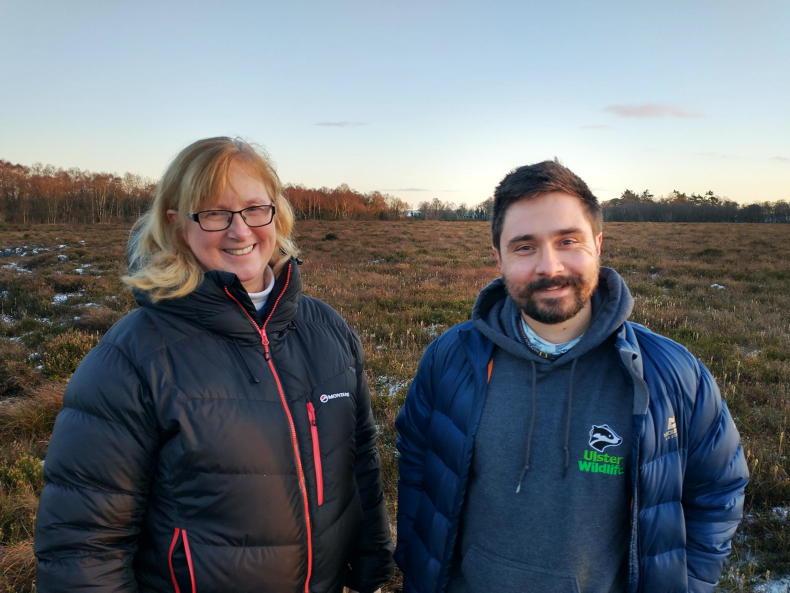

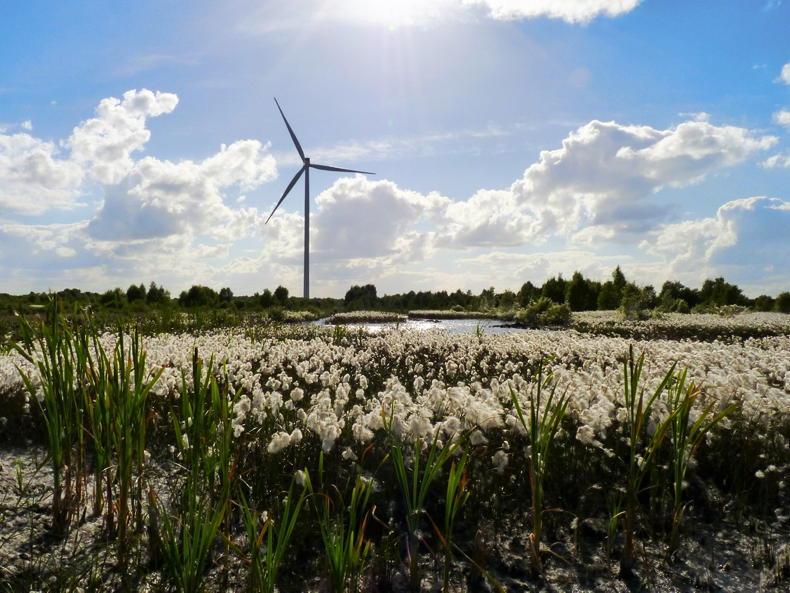
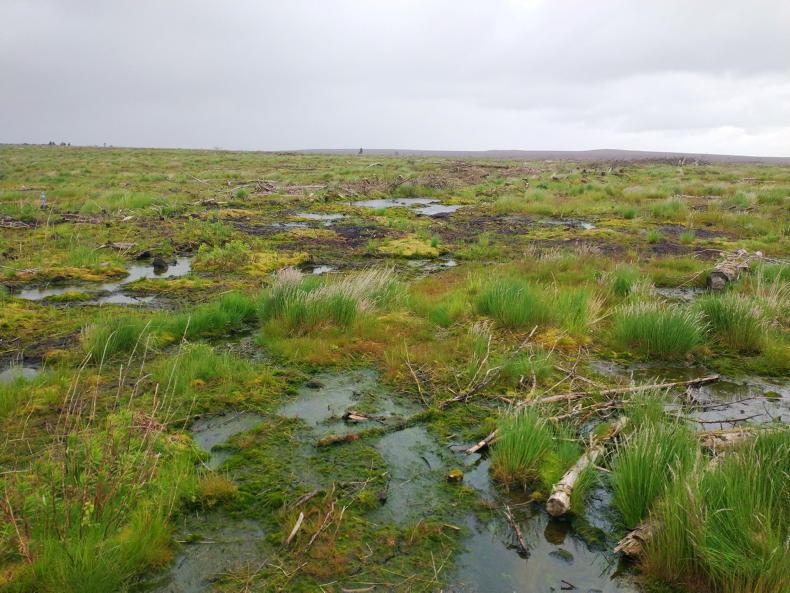

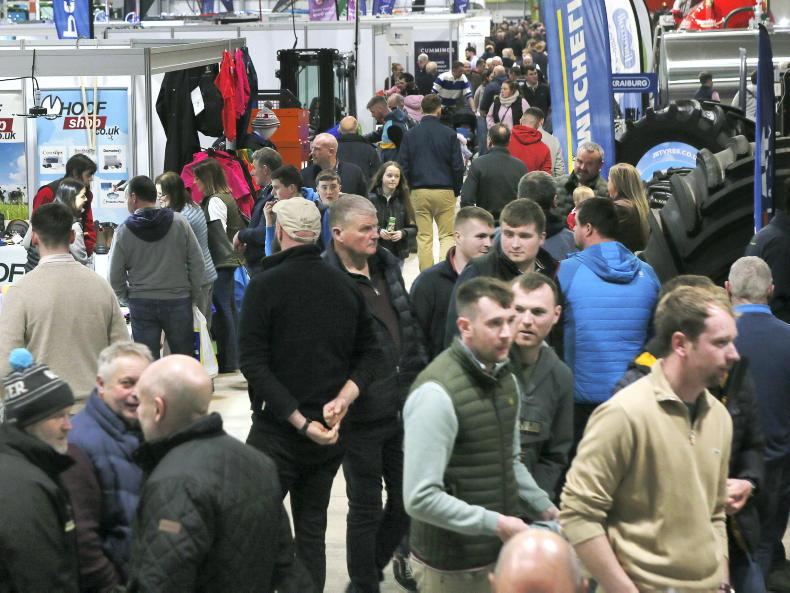
SHARING OPTIONS